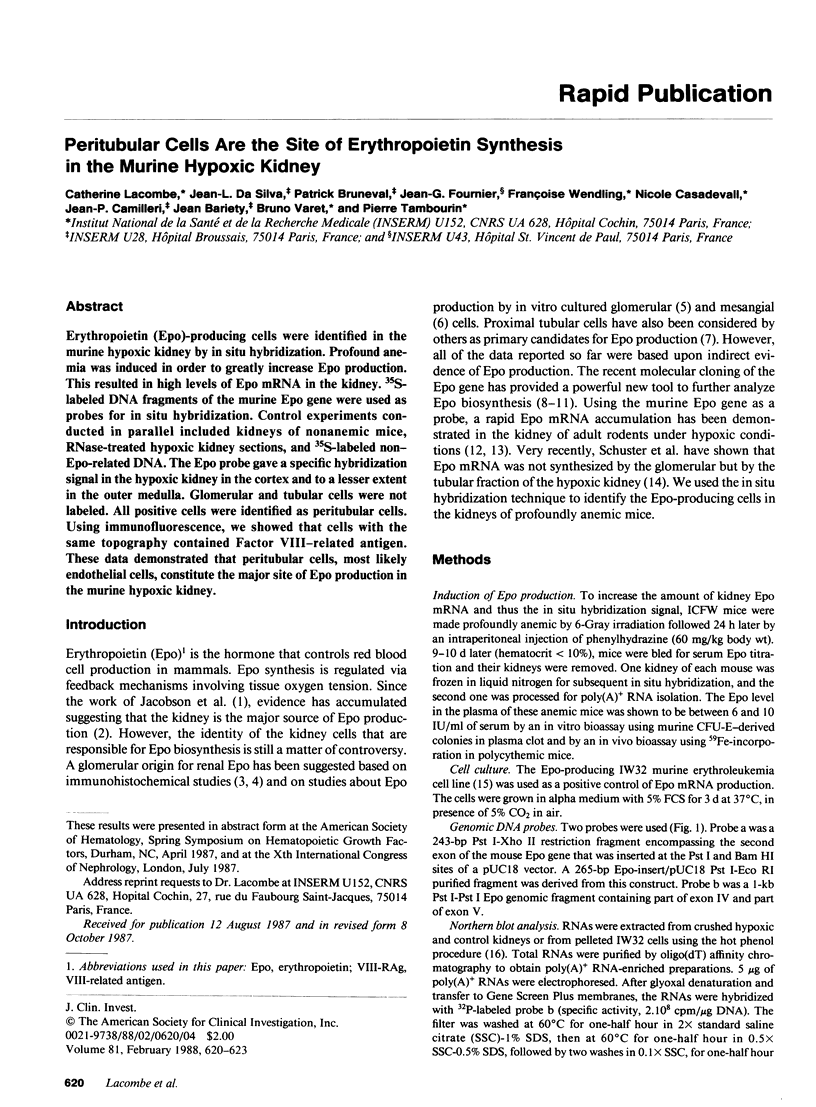Peritubular cells are the site of erythropoietin synthesis in the murine hypoxic kidney (original) (raw)
Abstract
Erythropoietin (Epo)-producing cells were identified in the murine hypoxic kidney by in situ hybridization. Profound anemia was induced in order to greatly increase Epo production. This resulted in high levels of Epo mRNA in the kidney. 35S-labeled DNA fragments of the murine Epo gene were used as probes for in situ hybridization. Control experiments conducted in parallel included kidneys of nonanemic mice, RNase-treated hypoxic kidney sections, and 35S-labeled non-Epo-related DNA. The Epo probe gave a specific hybridization signal in the hypoxic kidney in the cortex and to a lesser extent in the outer medulla. Glomerular and tubular cells were not labeled. All positive cells were identified as peritubular cells. Using immunofluorescence, we showed that cells with the same topography contained Factor VIII-related antigen. These data demonstrated that peritubular cells, most likely endothelial cells, constitute the major site of Epo production in the murine hypoxic kidney.

Images in this article
Selected References
These references are in PubMed. This may not be the complete list of references from this article.
- Beru N., McDonald J., Lacombe C., Goldwasser E. Expression of the erythropoietin gene. Mol Cell Biol. 1986 Jul;6(7):2571–2575. doi: 10.1128/mcb.6.7.2571. [DOI] [PMC free article] [PubMed] [Google Scholar]
- Bondurant M. C., Koury M. J. Anemia induces accumulation of erythropoietin mRNA in the kidney and liver. Mol Cell Biol. 1986 Jul;6(7):2731–2733. doi: 10.1128/mcb.6.7.2731. [DOI] [PMC free article] [PubMed] [Google Scholar]
- Burlington H., Cronkite E. P., Reincke U., Zanjani E. D. Erythropoietin production in cultures of goat renal glomeruli. Proc Natl Acad Sci U S A. 1972 Dec;69(12):3547–3550. doi: 10.1073/pnas.69.12.3547. [DOI] [PMC free article] [PubMed] [Google Scholar]
- Busuttil R. W., Roh B. L., Fisher J. W. Localization of erythropoietin in the glomerulus of the hypoxic dog kidney using a fluorescent antibody technique. Acta Haematol. 1972;47(4):238–242. doi: 10.1159/000208530. [DOI] [PubMed] [Google Scholar]
- Caro J., Erslev A. J. Biologic and immunologic erythropoietin in extracts from hypoxic whole rat kidneys and in their glomerular and tubular fractions. J Lab Clin Med. 1984 Jun;103(6):922–931. [PubMed] [Google Scholar]
- Choppin J., Lacombe C., Casadevall N., Muller O., Tambourin P., Varet B. Characterization of erythropoietin produced by IW32 murine erythroleukemia cells. Blood. 1984 Aug;64(2):341–347. [PubMed] [Google Scholar]
- Fournier J. G., Tardieu M., Lebon P., Robain O., Ponsot G., Rozenblatt S., Bouteille M. Detection of measles virus RNA in lymphocytes from peripheral-blood and brain perivascular infiltrates of patients with subacute sclerosing panencephalitis. N Engl J Med. 1985 Oct 10;313(15):910–915. doi: 10.1056/NEJM198510103131502. [DOI] [PubMed] [Google Scholar]
- Hawkins P., Anderson S. E., McKenzie J. L., McLoughlin K., Beard M. E., Hart D. N. Localization of MN blood group antigens in kidney. Transplant Proc. 1985 Apr;17(2):1697–1700. [PubMed] [Google Scholar]
- Hume D. A., Gordon S. Mononuclear phagocyte system of the mouse defined by immunohistochemical localization of antigen F4/80. Identification of resident macrophages in renal medullary and cortical interstitium and the juxtaglomerular complex. J Exp Med. 1983 May 1;157(5):1704–1709. doi: 10.1084/jem.157.5.1704. [DOI] [PMC free article] [PubMed] [Google Scholar]
- JACOBSON L. O., GOLDWASSER E., FRIED W., PLZAK L. Role of the kidney in erythropoiesis. Nature. 1957 Mar 23;179(4560):633–634. doi: 10.1038/179633a0. [DOI] [PubMed] [Google Scholar]
- Jacobs K., Shoemaker C., Rudersdorf R., Neill S. D., Kaufman R. J., Mufson A., Seehra J., Jones S. S., Hewick R., Fritsch E. F. Isolation and characterization of genomic and cDNA clones of human erythropoietin. 1985 Feb 28-Mar 6Nature. 313(6005):806–810. doi: 10.1038/313806a0. [DOI] [PubMed] [Google Scholar]
- Jelkmann W. Renal erythropoietin: properties and production. Rev Physiol Biochem Pharmacol. 1986;104:139–215. doi: 10.1007/BFb0031014. [DOI] [PubMed] [Google Scholar]
- Kurtz A., Jelkmann W., Sinowatz F., Bauer C. Renal mesangial cell cultures as a model for study of erythropoietin production. Proc Natl Acad Sci U S A. 1983 Jul;80(13):4008–4011. doi: 10.1073/pnas.80.13.4008. [DOI] [PMC free article] [PubMed] [Google Scholar]
- Lin F. K., Suggs S., Lin C. H., Browne J. K., Smalling R., Egrie J. C., Chen K. K., Fox G. M., Martin F., Stabinsky Z. Cloning and expression of the human erythropoietin gene. Proc Natl Acad Sci U S A. 1985 Nov;82(22):7580–7584. doi: 10.1073/pnas.82.22.7580. [DOI] [PMC free article] [PubMed] [Google Scholar]
- McDonald J. D., Lin F. K., Goldwasser E. Cloning, sequencing, and evolutionary analysis of the mouse erythropoietin gene. Mol Cell Biol. 1986 Mar;6(3):842–848. doi: 10.1128/mcb.6.3.842. [DOI] [PMC free article] [PubMed] [Google Scholar]
- Rich I. N., Heit W., Kubanek B. Extrarenal erythropoietin production by macrophages. Blood. 1982 Oct;60(4):1007–1018. [PubMed] [Google Scholar]
- Schuster S. J., Wilson J. H., Erslev A. J., Caro J. Physiologic regulation and tissue localization of renal erythropoietin messenger RNA. Blood. 1987 Jul;70(1):316–318. [PubMed] [Google Scholar]
- Shoemaker C. B., Mitsock L. D. Murine erythropoietin gene: cloning, expression, and human gene homology. Mol Cell Biol. 1986 Mar;6(3):849–858. doi: 10.1128/mcb.6.3.849. [DOI] [PMC free article] [PubMed] [Google Scholar]